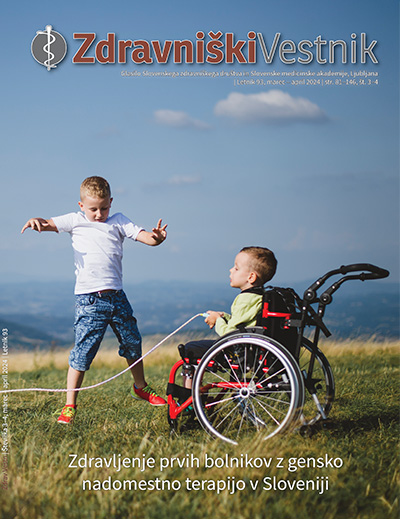The relevance and pitfalls of scientific research in medicine: how scientific research in medicine differs from other natural and social sciences
DOI:
https://doi.org/10.6016/ZdravVestn.3529Keywords:
medical progress, research, research bias, artificial intelligenceAbstract
The Slovenian Medical Academy (SMA), whose mission is also to encourage scientific research, has organised a roundtable on the relevance and pitfalls of scientific research in medicine. Participants stressed that science is a driving force for development in all areas of life, including medicine. Scientific research directly benefits medical practice and allows for better patient care. Medical science is in a unique position compared to other sciences, as most research is related to interventions in the physical integrity of the human body. It must therefore be under the scrutiny of oversight mechanisms that ensure the safety and ethicality of conduct in this field. A prior ethical assessment of all medical research is required, which is carried out by the Medical Ethics Committee. Scientific activity in medicine is in an unequal position compared to research in other fields since clinicians, in particular, are researchers only for a small part of their working time. Even in tertiary institutions, researchers are enthusiasts who perform research in their spare time.
Unfortunately, medical science is also often exposed to factors that threaten neutrality and objectivity, as the focus is on competitiveness and the interests of the institutions on which the research depends financially. Improvisation and even falsification of research results may occur. There are ever-increasing pressures in the academic sphere, and the publication of even far-fetched results is a prerequisite for promotion. Researchers are often dependent on research funding from sponsors (especially the pharmaceutical industry) rather than independent financial sources, which can affect the credibility of the results.
In recent years, research using artificial intelligence has joined the ranks of conventional research. Although artificial intelligence’s analysis of results is incomparably faster and more accurate it also has pitfalls: it is sometimes unclear whether the text is written by a human or by an artificial intelligence. In addition, there are also fictions in the records, which call into question the credibility of research findings.
Science is the driving force behind the development of medicine, but it must be value-neutral and based on verified facts.
Downloads
References
1. Goldenberg J. what is the role of scince indeveloping countries? Science. 1998;279(5354):1140-1.
DOI: 10.1126/science.279.5354.1140
2. Saunders J. The practice of clinical medicine as an art andas a science. West J Med. 2001;174(2):137-41.
DOI: 10.1136/ewjm.174.2.137
3. Selby P. The impact of the process of clinical research on health service outcomes. Ann Oncol. 2011;22:vii2-4.
DOI: 10.1093/annonc/mdr418
PMID: 22039140
4. Alliance for Life Sciences. White Paper on combining research, teaching and medical practice. Brno: CEITEC; 2023 [cited 2024 Feb 12]. Available from: https://alliance4life.ceitec.cz/white-paper-on-combining-research-teaching-and-medical-practice/.
5. Kelly J, Sadeghieh T, Adeli K. EJIFCC. 2014;25(3):227-43.
PMID: 27683470
6. Beauchamp T, Childress J. The Principles of Biomedical Ethics. Oxford: Oxford University Press; 1979.
7. Naylor CD. Grey zones of clinical practice: some limits to evidence-based medicine. Lancet. 1995;345(8953):840-2.
DOI: 10.1016/S0140-6736(95)92969-X
PMID: 7898234
8. Pugliese R, Regondi S, Marini R. Machine learning-based approach: global trends, research directions, and regulatory standpoints. Data Sci Manag. 2021;4:19-29.
DOI: 10.1016/j.dsm.2021.12.002
9. Haug CJ, Drazen JM. Artificial intelligence and machine learning in clinical medicine, 2023. N Engl J Med. 2023;388(13):1201-8.
DOI: 10.1056/NEJMra2302038
PMID: 36988595
10. Rajpurkar P, Lungren MP. The current and future state of AI interpretation of medical Images. N Engl J Med. 2023;388(21):1981-90.
DOI: 10.1056/NEJMra2301725
PMID: 37224199
11. Gomes B, Ashley EA. Artificial intelligence in molecular medicine. N Engl J Med. 2023;388(26):2456-65.
DOI: 10.1056/NEJMra2204787
PMID: 37379136
12. Rajpurkar P, Chen E, Banerjee O, Topol EJ. AI in health and medicine. Nat Med. 2022;28(1):31-8.
DOI: 10.1038/s41591-021-01614-0
PMID: 35058619
13. Lin S, Li Z, Fu B, Chen S, Li X, Wang Y, et al. Feasibility of using deep learning to detect coronary artery disease based on facial photo. Eur Heart J. 2020;41(46):4400-11.
DOI: 10.1093/eurheartj/ehaa640
PMID: 32818267
14. Kotanidis CP, Antoniades C. Selfies in cardiovascular medicine: welcome to a new era of medical diagnostics. Eur Heart J. 2020;41(46):4412-4.
DOI: 10.1093/eurheartj/ehaa608
PMID: 32822487
15. Lee P, Bubeck S, Petro J. Benefits, limits, and risks of GPT-4 as an AI chatbot for medicine. N Engl J Med. 2023;388(13):1233-9.
DOI: 10.1056/NEJMsr2214184
PMID: 36988602
Downloads
Published
Issue
Section
License

The Author transfers to the Publisher (Slovenian Medical Association) all economic copyrights following form Article 22 of the Slovene Copyright and Related Rights Act (ZASP), including the right of reproduction, the right of distribution, the rental right, the right of public performance, the right of public transmission, the right of public communication by means of phonograms and videograms, the right of public presentation, the right of broadcasting, the right of rebroadcasting, the right of secondary broadcasting, the right of communication to the public, the right of transformation, the right of audiovisual adaptation and all other rights of the author according to ZASP.
The aforementioned rights are transferred non-exclusively, for an unlimited number of editions, for the term of the statutory
The Author can make use of his work himself or transfer subjective rights to others only after 3 months from date of first publishing in the journal Zdravniški vestnik/Slovenian Medical Journal.
The Publisher (Slovenian Medical Association) has the right to transfer the rights of acquired parties without explicit consent of the Author.
The Author consents that the Article be published under the Creative Commons BY-NC 4.0 (attribution-non-commercial) or comparable licence.



